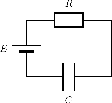| << Chapter < Page | Chapter >> Page > |
A parallel plate capacitor is a device that consists of two oppositely charged conducting plates separated by a smalldistance, which stores charge. When voltage is applied to the capacitor, usually by connecting it to an energy source (e.g. a battery) in a circuit, electric charge of equal magnitude, but oppositepolarity, builds up on each plate.

Capacitance is the charge stored per volt and is measured in Farads (F).
Mathematically, capacitance is the ratio of the charge on a single plate to the voltage across the plates of the capacitor:
Capacitance is measured in Farads (F). Since capacitance is defined as , the units are in terms of charge over potential difference. The unit of charge is the coulomb and theunit of the potential difference is the volt. One farad is therefore the capacitance if one coulomb of charge was stored on acapacitor for every volt applied.
1 C of charge is a very large amount of charge. So, for a small amount of voltage applied, a 1 F capacitor can store a enormousamount of charge. Therefore, capacitors are often denoted in terms of microfarads ( ), nanofarads ( ), or picofarads ( ).
Suppose that a 5 V battery is connected in a circuit to a 5 pF capacitor. After the battery has been connected for a long time, what isthe charge stored on each of the plates?
To begin remember that after a voltage has been applied for a long time the capacitor is fully charged. The relation betweenvoltage and the maximum charge of a capacitor is found in equation [link] .
Inserting the given values of and , we find that:
The electric field between the plates of a capacitor is affected by the substance between them. The substance between the plates is called a dielectric. Common substances used as dielectrics are mica, perspex, air, paper and glass.
When a dielectric is inserted between the plates of a parallel plate capacitor the dielectric becomes polarised so an electricfield is induced in the dielectric that opposes the field between the plates. When the two electric fields are superposed, the newfield between the plates becomes smaller. Thus the voltage between the plates decreases so the capacitance increases.
In every capacitor, the dielectric stops the charge on one plate from travelling to the other plate. However, each capacitor isdifferent in how much charge it allows to build up on the electrodes per voltage applied. When scientists started studyingcapacitors they discovered the property that the voltage applied to the capacitor was proportional to the maximum charge that wouldaccumulate on the electrodes. The constant that made this relation into an equation was called the capacitance, C. Thecapacitance was different for different capacitors. But, it stayed constant no matter how much voltage was applied. So, it predictshow much charge will be stored on a capacitor when different voltages are applied.

Notification Switch
Would you like to follow the 'Siyavula textbooks: grade 11 physical science' conversation and receive update notifications?